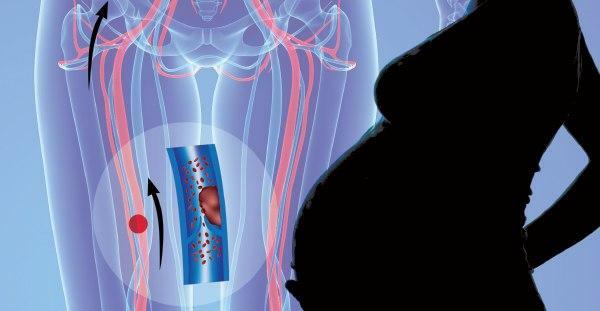The D-dimer is a substance that is a small protein fragment consisting of two D components of fibrinogen. D-dimer is formed as a result of the cleavage of fibrin, a high molecular weight protein that is synthesized by the liver cells after the decomposition of the thrombus. The number of D-dimers in the blood of a pregnant woman helps determine the degree of clotting, the presence of blood clots and the risk of thrombosis. This analysis is especially important in the third trimester, so the birth is always accompanied by profuse blood loss.
D-dimer in pregnancy is usually elevated. This is due to the physiological processes that occur in the body of a woman under the influence of hormonal changes. In spite of this, the D-dimer level must be within the limits of acceptable values. If the excess is significant, it is necessary to exclude possible pathologies, since such a clinical picture increases the risk of formation of thrombosis. Against the backdrop of varicose veins, which affect almost a third of pregnant women, the situation can lead to unfortunate consequences.

D-dimer increased in pregnancy
Content of the material
- 1 D-dimer during pregnancy: what is considered the norm?
- 2 How to prepare for the analysis?
- 3 D-dimer increased: what could be the reason?
- 3.1 Pathological Causes
- 3.2 Video - Pregnancy Test
- 4 D-dimer increased: what to do?
D-dimer during pregnancy: what is considered the norm?
For pregnancy, the level of D-dimer increases by an average of 3 times compared with ordinary women who have no health problems. The maximum concentration is reached in the third trimester, when the body begins to prepare for the forthcoming birth and possible abundant blood loss. The increase in D-dimer( as well as its decrease) is dangerous for a woman. In the first case, the risk of blood clots and clogging of blood vessels and arteries increases. In the second, the probability of profuse and prolonged postpartum hemorrhage increases, since the blood will not fold.
To determine the amount of D-dimers, venous blood is taken for the study. The analysis requires some preparation, therefore, in order to obtain a reliable result, a woman should follow medical recommendations. Based on the results of the study, the doctor will make a conclusion about the risk of thrombophilia and the prognosis of labor.

What is the D-dimer
The acceptable values for each gestation period are given in the table below.
| Duration of gestation | Values of the norm( ng / ml) |
|---|---|
| Up to 12-14 weeks | ≤ 750 |
| From 14 to 28-30 weeks | ≤ 1000 |
| From 30 weeks before delivery | ≤ 1500 |
Important! The analysis for D-dimer is not included in the list of mandatory studies during pregnancy, but monitoring of this indicator is necessary. In most cases, women are prescribed this type of examination when taking anticoagulants - drugs that dilute blood. An increased level of D-dimer can lead to postpartum thrombophilia, so experts advise women to do this analysis on their own for 30-32 weeks to understand the possible risks.
How to prepare for the analysis?
In order for the result of the analysis to be as accurate as possible, the woman will have to prepare for it correctly. The main restrictions apply to nutrition. One day before taking blood it is necessary to exclude from the diet any heavy food. This rule applies mainly to those who do not follow a diet for pregnant women and tolerate inaccuracies in the diet. By strict ban are: any fried foods, dishes with high fat content( fat, butter, fatty sour cream), as well as products containing irritating substances( spices, vinegar).This includes any conservation and all kinds of snacks, crisps and crackers.

D-dimer in pregnancy
You need to give blood to an empty stomach. The last meal should be at least 8 hours before the test( doctors recommend to maintain the interval at 12 hours, but with late toxicosis it will be quite difficult).You can drink water half an hour before the test.
It is equally important to adhere to other recommendations:
- on the eve of the analysis not to be in the same room as people smoking;
- not to be nervous and not subject yourself to emotional unrest( not to meet with unpleasant people, do not watch dramatic movies, etc.);
- immediately before the analysis should be 10-15 minutes to sit and let the body rest and relax.
Important! All medications should be stopped 2 weeks before the test. If this is not possible for life, the lab technician should make a note, as some drugs can affect the result of the analysis. In the period of infectious diseases, it is better to abandon this type of examination and go through it 10-14 days after recovery.

Steps to accurately determine the result of D-dimer in pregnancy
D-dimer increased: what could be the reason?
If the D-dimer level is significantly higher than the norm, it is necessary to find out the cause, in order to reduce the risk of complications during childbirth. It is for this reason that blood donation is recommended for a period of 30-32 weeks( about 7 months), so that there is time to eliminate the provoking factors and undergo treatment if necessary.
Most often, elevated D-dimer is detected simultaneously with other signs of gestosis, which is called late toxicosis. The condition is considered quite dangerous, as it promotes the development of pre-eclampsia - a condition in which a woman's cerebral circulation is disturbed. The gestosis of the second half of pregnancy is also characterized by other signs. Doctors distinguish three of them:
- arterial hypertension, poorly amenable to drug correction;
- is a protein in the urine;
- accumulation of fluid in soft tissues and subcutaneous fat, expressed by swelling of the limbs, face and neck.
Treatment of gestosis is aimed at eliminating edema, reducing pressure and correcting the lifestyle of a future mother. In some cases, a woman can be prescribed a bed rest until the very birth. In severe cases, hospitalization in the department of pregnancy pathology is indicated.

The main causes of elevated D-dimer levels during pregnancy
A slight increase in the number of D-dimers in the blood can be associated with multiple pregnancies, as well as surgical interventions that took place 1-2 years before the onset of pregnancy. Respiratory infections, injuries of various origins( including burn wounds) cause a temporary increase in the D-dimer, which passes after stabilization of the condition.
Pathological causes of
A separate group of reasons contributing to the increase in D-dimer are chronic, hidden and sluggish diseases with poorly traced symptoms. These include:
- diabetes mellitus( including gestational form - diabetes of pregnant women);
- liver pathology, accompanied by a violation of bile outflow and death of hepatocytes( organ cells);
- diseases of the renal system with partial renal dysfunction, as well as signs of inflammation( eg, chronic pyelonephritis);
- disorders in the functioning of the heart or inflammatory diseases of the inner and outer layers of the heart muscle( pericarditis, myocarditis);
- is an allergy that has a chronic course( provided that the pregnant woman constantly contacts allergens).

Consequences of increasing the D-dimer
Important! In some cases, an increase in D-dimer may be the first sign of a beginning placental abruption. In this case, a woman may notice the following symptoms: pain in the abdomen( intensity depends on the individual pain threshold), spotting, dizziness and nausea. The appearance of these signs is an alarming symptom at any time of pregnancy, requiring immediate treatment to a specialist. The timeliness of the provision of medical care depends on the child's life, so you can not ignore pathological symptoms.
Video - Pregnancy tests
D-dimer increased: what to do?
If the excess of the norm is insignificant, and the woman's well-being does not cause fear, the treatment can be carried out on an outpatient basis, but the future mother will still have to visit the day hospital. In most cases, two drugs are used for therapy: Nadroparin calcium( Fraksiparin) and Reopoliglyukin. The first drug is used in the form of a solution for injection and dilutes the blood. The injection is placed in the zone around the umbilical ring. The procedure is not very painful, but there may be slight burning and tingling at the site of the injection. These reactions are considered normal and should not cause concern if they pass alone 10-30 minutes after the injection.
"Reopoliglyukin" is used for signs of thrombosis and a tendency to thromboembolism. It promotes resorption of blood clots and ensures free circulation of blood through the vessels. The drug is most often used for drip infusion with the help of infusomat. The procedure is carried out in the day care center of a polyclinic at the place of residence.

Assay for D-dimer
Women who are diagnosed with an elevated D-dimer are advised to drink more fluid - this will promote natural blood thinning and prevention of blood clots. Useful and will be physical education. It is better if it will be special classes for pregnant women, which are held in schools for expectant mothers and in a women's consultation. Walking in the open air, the correct organization of work and rest, a balanced concept also play a big role in the prevention of thrombophilia, therefore, it is not worth neglecting the advice of specialists during the gestation.
In rare cases, a woman at the planning stage can be shown to consult a geneticist. If any of the close relatives of a prospective mother had abnormalities in the functioning of the hematopoiesis system, the risk of thrombosis during pregnancy increases, so it is better if the expected prognosis of pregnancy and childbirth is determined in advance. Early diagnosis of possible problems will allow to take into account the risks and increase the chances of successful conception and bearing of the fetus, and will reduce the likelihood of complications during childbirth and in the postpartum period.



